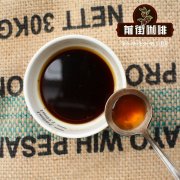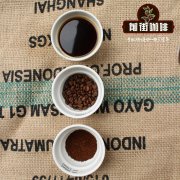Talk about mixed Coffee. What's the stem? What's the difference between mixed coffee and instant coffee?

Professional coffee knowledge exchange more coffee bean information please follow the coffee workshop (Wechat official account cafe_style)
Talking about coffee: mixed coffee has successively formulated coffee beans.
"what's wrong with stir-frying cabbage and beef?" A middle school student studying abroad asked, and then he said, "it would be better to eat raw beef."
I smiled and said, "so if you fry the raw eggs and bacon in the pan together, what will happen to the eggs when the bacon is cooked?" Without thinking about it, he replied, "of course I will take out the fried eggs!" Bacon needs to be a little more patient before it is fully cooked. "
"so how to get out the coffee beans that have been mixed together?" After this question, he seems to have come to his senses.
The mixed coffee beans are stable and the other is to reduce the cost.
Mix the coffee beans, one is to keep the taste stable and balanced, and the other is to reduce the cost. Italian coffee (espresso) on the streets of Rome is usually mixed with cheap, high-caffeinated robusta varieties with a thicker taste and a golden layer of crema. So far, Europeans have been more receptive to robusta than those affected by the wave of boutiques. From the cup point of view, robusta and liberica had less fruit acid and organic sugar. After baking, the taste is sweet and bitter, but the aroma is not enough, so it is only suitable for the "bottom taste" of formula or instant coffee. At present, most of the coffee varieties advocated by the coffee industry are arabica or its derivatives. Italian illy's signature formula coffee (illy blend) consists of nine types of arabica beans. The advantage of mixing so much coffee is the "lack of specialty". Even if the supply of a certain ingredient is unstable or the quality of the ingredient is declining, it will not affect the overall feeling. If there is less in the 24 flavors, I believe that generally not too many people can drink it.
Pay attention to balanced post-blending
"Pre-blending is baking mixed raw beans. Because the density, treatment and water content of different ingredients of coffee are different. If you stir-fry at the same firepower time, it may lead to uneven raw and cooked; it doesn't matter if the goal of baking is'no sour fruit, all charred'. But modern coffee is balanced, and roasters usually bake it alone according to the characteristics of various beans before putting it together, just as sun eggs and bacon are not fried together. This mix is called post-blending. "
"there are established bakers in Japan who advocate that beans are classified according to their size, color and performance after heating, regardless of the origin of beans. He said that the coffee in Kenya and the Huehuetenango in Vetnango, Guatemala, are of the same category and are more suitable for deep stir-frying. " Some enthusiasts like to collect coffee books. His knowledge is more professional than many people in the coffee industry.
"you mean the 'systematic caffeine' advocated by Taguchi, the founder of the Baja Cafe in Tokyo!" My answer: "the book Coffee published in 2004 refers to the commercial grade coffee he has used for decades. Due to the lack of characteristics of raw beans, even coffee produced in different states can be classified according to the physical properties (physical properties) of beans. But he also caught up with the trend of boutique, published the Collection of Fine Coffee last year, and admitted that when stir-frying boutique coffee beans, there is a need to strike a balance between preserving the personality of the beans and the habits of the baker. "
"for example, now we compare the taste of the black dolphin in Kagoshima in Japan and the black-hoofed pig in Iberico of Spain. And he lived in an era where there was only ordinary pork. Systematic classification is like asking the owner of a meat stall in the market: 'can you make soup with tailbone and steamed meatloaf? Of course I've lost weight with a half-fat head!' "
Patrick Tam (owner of the boutique coffee shop Knockbox, approved barista of the American Fine Coffee Association and European Fine Coffee Association, CQI recognized cup tester, Cup of Excellence's first Hong Kong judge)
Important Notice :
前街咖啡 FrontStreet Coffee has moved to new addredd:
FrontStreet Coffee Address: 315,Donghua East Road,GuangZhou
Tel:020 38364473
- Prev

Three major trends of coffee roasting mixed coffee is still the mainstream mixed coffee what does it mean?
Professional coffee knowledge exchange more coffee bean information please follow the coffee workshop (Wechat official account cafe_style) 1. From light to medium roasting, there are three factors that determine the flavor of coffee: sweet, sour and bitter. Generally speaking, the longer the baking time, the less sour, but the bitterness will increase, and the sweetness is between the peak of sour and bitter. The coffee industry used to
- Next

There is a secret to the proportion of mixed coffee! Why is the typical proportion of mixed coffee at 3:7?
Professional coffee knowledge exchange more coffee bean information please follow the coffee workshop (Wechat official account cafe_style) in the coffee industry jargon, only stir-fry raw beans from a certain place and brew, this kind of coffee is called pure coffee, not that pure coffee can not be tasted, as long as you like its unique flavor and personality, tasting pure coffee will be a top enjoyment. But through mixing,
Related
- Guji coffee producing area of Guji, Ethiopia: Humbela, Shakiso, Wulaga
- What is the most expensive variety of Qiloso in BOP multi-variety group?
- How to store the coffee beans bought home?
- Why are Yemeni coffee beans so rare now?
- Ethiopian Sidamo all Red Fruit Sun Sun Santa Vini Coffee beans
- SOE is mostly sour? What does it mean? Is it a single bean? what's the difference between it and Italian blending?
- Is Italian coffee beans suitable for making hand-brewed coffee?
- How to choose coffee beans when making cold coffee? What kind of coffee beans are suitable for making cold coffee?
- Just entered the pit to make coffee, what kind of coffee beans should be chosen?
- Can only Japan buy real Blue Mountain Coffee? What are authentic Jamaican Blue Mountain coffee beans?

